Foreign Insulators
by Marilyn Albers
Reprinted from "INSULATORS - Crown Jewels of the Wire", September 1979, page 4
Zsolnay Ceramics, Pecs, Hungary
The insulator you see pictured on
the left is one of my most prized possessions. I bought it last summer at the
National Show in Reno from Mr. Paul Bellanyi of Sacramento, California, who
kindly furnished me with information on the manufacturer -- Zsolnay Ceramic
Factory of Pecs, Hungary. I was particularly glad to have this insulator because
I had visited Budapest in the summer of 1977 and had been so impressed with the
people, the happy atmosphere of the city, the flowers everywhere, the beautiful
countryside, etc., etc. As you know, Hungary is now under Communist control, but
the spirit of the people has never been crushed!
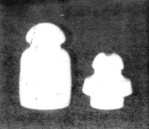
The Zsolnay factory was founded
in 1851. At that time they manufactured building ceramics for the construction
trade, as well as household goods. The founder of the factory was Micheal
Zsolnay. Shortly after 1854 his sons, Ignacio and Williams Zsolnay, took over,
and they developed it into a much larger factory -- it became quite a giant. At
that time their main ambition was to give a highly artistic look to their
product. Williams Zsolnay, especially, (1828-1900) worked very hard to
manufacture the highest quality and the most refined artistic ceramics.
In 1873,
at the Big Fair in Vienna, Austria, Zsolnay had its first big success with the
very fine quality and outstanding designs of its household goods. In 1878 at the
World Exhibition in Paris, Zsolnay presented for the first time its very
colorful porcelain stove ware. It had an ivory colored base and was decorated
with flowers in original colors. All parts were coated with a very shiny glaze.
These same items were also exhibited in Milan and Torino in Italy.
In the early
part of 1880 Zsolnay developed a product called PYROGRANIT. It was a heat and
frost resistant material mostly used for making stoves and exquisite ornaments
for decorations on buildings. The product was in great demand by the well known
architects LECHNER, STEINDL, ALPAR, and HAUSZMANN. It is not known whether the
insulator in question was made with pyrogranit, or even if cost would permit;
but it is an interesting speculation, and would surely result in the
"perfect insulator".
The greatest and most important development in
the history of the Zsolnay factory was the invention of EOSIN. It was developed
by Williams Zsolnay with the help of Mr. VINCENS WARTHE and LUDWIG PETRICK. The
product was ready for use in 1890. It was the foundation of the immortal name of
Zsolnay. EOSIN was a highly glossy glaze which was available in green, blue, or
red, and reflected all the colors of the spectrum. It would have been used on
expensive figurines and household ornaments, however, rather than building
ceramics for construction use.
After the death of Williams Zsolnay in
1900, his son Micheal took over the plant management. In 1920 Micheal passed
away, and the management of the plant was taken over by his two daughters, his
sons-in-law, and later by the grandchildren. In the further development of the
artistic part of their products, Micheal's daughters, TERESA (Mrs. MATTYASOVSKI)
and JULIA (Mrs. SIKORSKI), played a very vital part. They favored Hungarian
motifs; but later on some Persian and Hindu motifs were used.
The factory is
still in operation today. As I mentioned before, Hungary is one of the countries
behind the Iron Curtain. In 1945, after World War II, when the Communists took
over, the Zsolnay plant and all other factories became State property. According
to Paul's information, the "new" management was desperately after the
EOSIN formula, but it was a very closely guarded secret of the Zsolnay family,
and no outsider had any success in getting ahold of the original formula.
Persons who knew it and refused to turn it over to the new management eventually
mysteriously vanished!
All the old pieces of Zsolnay that remain in Hungary are
registered with the State, even if they are privately owned. These are, of
course, collector's items today, and are very expensive. They are closely
watched, and if someone wants to take one out of the country, he has to get a
special permit to do so. Paul is lucky enough to have a few of the old pieces in
his possession, and he says that it is absolutely impossible to describe their
beauty. He calls each piece a European Tiffany!
Zsolnay products manufactured
today are of a lot less quality in every way. Paul has a few of these also. The
old pieces are easily recognizable -- the big difference being in the color and
quality.
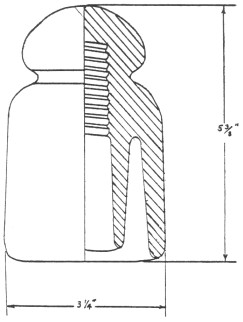
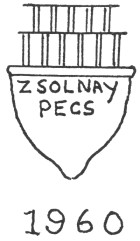
Now that we've had our history lesson, let's look at the Zsolnay
insulator, the one on the left in the photo. It resembles a fat white jug! It is
definitely a power insulator. It bears the Zsolnay trademark and was made in
1960 at their plant in Pecs. A friend of Paul's brought it to him nine years
ago, and, as you might have guessed, it is now chained to my shelf!
The general
shape of the insulator is not so unusual; in fact, it is quite commonly seen
throughout Poland, Germany, and Switzerland. While going up a ski lift in
Interlaken, Switzerland, I saw hundreds on power poles -- what is unusual is the
size. It stands a husky 5-3/8" tall and is extremely thick, and
consequently is quite heavy. (A real friend to haul that all the way home, eh?)
The quality of the ceramic material used is definitely superior to the other
European porcelains I have.
The olive colored ink underglaze marking on the
skirt is not too clearly discernable; but after seeing a sketch of the true
Zsolnay trademark, I can see that they are one and the same. No other factory in
Hungary makes ceramics in such large quantity for the industry as Zsolnay.
My
own trip to Hungary in 1977 resulted in the acquisition of the insulator
pictured on the right. It is plain vanilla except for an H incuse marking on the
dome. I don't know who manufactured it -- perhaps Zsolnay??, but the H stands for
Hungary.
"Andy" was our young officially appointed tour guide while in
Budapest. He was a native Hungarian, and this city was his home. After he had
grinned and rolled up his eyes a lot, he agreed to help me find an insulator. It
turned out well because his friend came upon two of them while helping to tear
down an old building across the street from our Youth Hostel. These he presented
to me in a brown bag just as our group was about to board the train to
Czechoslovakia. It didn't matter that they were filthy, covered with soot,
filled with "critters", and cemented to heavy, ungainly metal pins
they were beautiful!!
- - - - - - - - -
Please make use of the following information on how to
make shadow profile drawings of your foreign insulators -- and make two copies
-- one for you and one for my file. Your help will be sincerely
appreciated, and is really quite necessary if there is to be any sort of
organization on foreign insulators. We've started, but the file is still pretty
skinny! C'mon y'all!! Send to: Marilyn Albers, 14715 Oak Bend Dr., Houston, TX
77079.
RECORDING INFORMATION ON INSULATORS
Very good drawings of insulators can
be made through the mail with the use of a "shadow profile" and
carefully measured dimensions as follows:
Place the insulator over a sheet of
paper on the floor directly below a ceiling light fixture. Plumb the true
vertical with a length of string. Unscrew all but one bulb in the fixture to
eliminate multiple shadows. Prop up the top of the insulator so its axis will
remain parallel with the floor without having to hold it.
Now get down on your
tummy and carefully trace onto the paper the shadow cast by the insulator. This
should look like Figure A on the following page. Don't tweak up the lines on
this profile or add any other detail to it (dimensions, hidden lines, etc.).
Now
make a separate sketch of the insulator as shown in Figure B on the following
page. Sketch onto it the hidden lines not shown by the profile. Carefully
measure the dimensions needed for us to complete the drawing, and add these to
the Figure B sketch as shown.
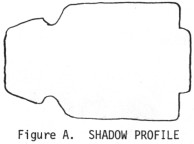
Also measure the overall insulator height,
the overall base diameter, and the diameter at some indicated point near the
insulator crown. (The drawings at the left are reduced in size to fit on this
page.)
If the insulator has a saddle top or other details which don't show up in
the shadow profile, try to sketch those details on a separate sketch to show
what they look like. Some oddball insulators with protruding pieces may also
require an additional shadow profile looking down from the top, or a shadow
profile viewing the insulator rotated 1/4-turn on its axis.
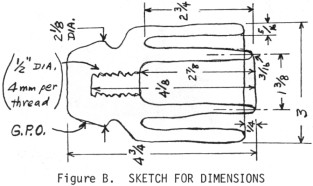
Lacking calipers,
outside diameters can be measured by placing the insulator between two stacks of
books and then measuring that distance. The depths of pinhole and recesses
between petticoats can be measured by using a narrow strip of cardboard and then
measuring its penetration. Measure or estimate the pinhole diameter (the minor
thread diameter near the threads collar).
Thread pitch (threads per inch) is
helpful in attributing foreign insulators, since a given country usually uses
one thread size throughout. England and related countries use English-unit
threads (threads per inch). Most other European countries use metric threads
(millimeters per thread). You can determine the exact thread type and its pitch
as follows:
Smooth a small piece of new kitchen foil by rubbing it with your
finger on a flat surface. For large pinholes, cut a 1/2" foil strip and
insert it into pinhole. Press foil against thread with your finger. For small,
deep pinholes, insert a 1/4" foil strip and then on top of that a 1/4"
strip of innertube or other rubber (tweezers help here). Insert a round pencil
on top of the rubber and press hard on the rubber while rolling the pencil and
slightly rocking it back and forth.
Measure from the foil the threads per inch
(or twice the number per 1/2"). If that doesn't come out to a whole number,
measure thread-to-thread in millimeters (or for 3 threads and divide by 3). If
metric threads, this should come out a whole number.
Copy all the insulator
markings as best you can, and indicate location of markings on the insulator. On
porcelains, indicate type of marking: incuse, underglaze ink, or sandblast. Good
foil impressions of incuse markings can be made by repeatedly pressing smoothed
foil hard with a rubber eraser. Dry a puddle of glue on the back for mailing.
| 